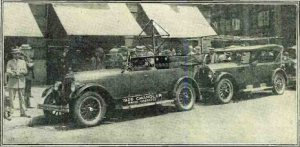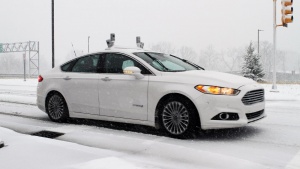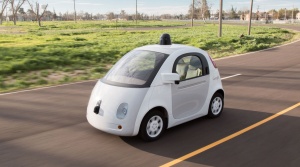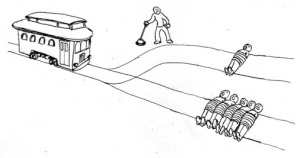Autonomous Vehicles
Autonomous cars (self-driving cars, robot cars, automated cars) are cars that are able to sense their surroundings and use the data to make decisions. Autonomous cars have come a long way in the last twenty years improving from simpler park assist technologies to vehicles that are able to sense surroundings, change lanes, and make emergency stops. Self driving cars have been featured at Expos and Worlds Fairs and more recently have made appearances at the North American International Auto Show and the Consumer Electronics Show. Overall these cars are safer than traditional driving because they can sense obstacles and react to them quicker than humans [1]. There are however, some ethics to the safety. Since vehicles and their tendencies are designed by teams of humans there is debate about who should make the decisions about how the cars should act.
Contents
History
Beginnings
Autonomous cars have origins in the 1920s when then Houdini Radio Control Company installed radio control equipment in a 1926 Chandler [2]. From 1950 to 1980 numerous companies and universities attempted to control cars by laying guide wires in the roadway [3]. These electronically controlled cars made appearances at numerous world showcases. When the 1990s rolled around we saw a jump from automated vehicles to today’s autonomous vehicles.
Today
Modern self-driving cars do much more than follow wires placed in the road way. Modern designs attempt to enable cars to make decisions about routes and about safety, changing lanes when they see congestion or avoiding debris in the road way. This technology is leaps and bounds from previous models which were controlled by humans on the other end of a remote control. Modern vehicles use a combination of radar, GPS, odometers, computer programs, and machine learning to take stock of their environment and make decisions accordingly.
Legislation
With rapid developments still happening in the field of autonomous cars it is hard for regulatory agencies to make laws about their design and usage. Today 12 states have enacted legislature pertaining to autonomous vehicles[4]. Most laws in regards to autonomous vehicles are similar to Michigan Senate Bill 0169, which was passed in 2013. It defines automation:
“Automated technology” means technology installed on a motor vehicle that has the capability to assist, make decisions for, or replace an operator.
Definines what an operator of an autonomous vehicle is:
Sec. 35a. “Operate” or “operating” means 1 or more of the following:
(a) Being in actual physical control of a vehicle. This subdivision applies regardless of whether or not the person is
licensed under this act as an operator or chauffeur.
(b) Causing an automated motor vehicle to move under its own power in automatic mode upon a highway or street
regardless of whether the person is physically present in that automated motor vehicle at that time. This subdivision
applies regardless of whether the person is licensed under this act as an operator or chauffeur. As used in this subdivision,
“causing an automated motor vehicle to move under its own power in automatic mode” includes engaging the automated
technology of that automated motor vehicle for that purpose.
And explains the registration and insurance protocol for such a vehicle[5]. Michigan Senate Bill 0663, also passed in 2013 explains that a manufacturer is free of liability if a third party makes any altercations to a vehicle [6]. Other laws like Tennessee Senate Bill 307 make it illegal for local municipalities to ban the use of autonomous vehicles [7].
Current Models
Many of the worlds leading automakers along with technologies companies are developing autonomous vehicles or autonomous technology for vehicles. Most estimate that they will be producing an at least partially autonomous vehicle by 2020. Some companies developing autonomous vehicles include Audi, BMW, Ford, General Motors, Google, Mercedes Benz, Nissan, Tesla, Toyota, Uber, Volkswagen, and Volvo.
Ford
Ford calls themselves one of the pioneers in autonomous vehicle technology and has recently began testing their vehicles at the University of Michigan’s Mcity and conducting real world snow tests [8][9]. Ford has two generations of autonomous vehicles. In 2003 Ford installed LiDAR technology on an F-250 Super Duty for participation in the DARPA challenge. The second generation of testing began in 2011 with the Ford Fusion sedan because of its advanced electrical systems. In January of 2016 Ford announced that it would expand its fleet of autonomous Fusions to 30 vehicles [10].
Google’s self-driving car project, based out of Mountain View, California, began in 2009 and hit the road for testing in 2012 [11]. Currently Google operates two types of autonomous vehicles. The first group is composed of Toyota Priuses and Lexus RX450hs. These vehicles are used by engineers to test driving systems in real world traffic. Google has begun testing a concept car developed in collaboration with Bosch, ZF Lenksysteme, LG, Continental, and Roush [12]. These vehicles are designed without peddles or steering wheels. As part of their concept car experiment Google has asked citizens to submit artwork for their Paint the Town initiative. Artwork has been featured on cars in Mountain View, California, and Austin, Texas. Google expects to have vehicles available for purchase in 2020. The cars still need to undergo testing in both snow and heavy rain [13].
Ethical Concerns
Computer ethicists and informed citizens alike are closely following the development of autonomous cars. With transition from automated to autonomous there are an increased number of decisions that must be made by designers[14].
Responsibility
Much of the legislation relating to autonomous vehicles has related to responsibility. The question is whether consequences from autonomous cars should fall on manufacturers, owners, or others. This debate is furthered when cars are considered autonomous agents and have the ability to learn and change themselves. Product liability laws are one venue of research on this dilemma that places responsibility for defects, injuries, and other unforeseen negative effects of sold products on any entities involved in the manufacture or selling processes. Being as autonomous cars are a tangible product, these laws may provide a framework for how responsibility can be regulated. [15]
Trolley Problem
The trolley problem, or trolley dilemma, is a thought experiment used be ethicists and designers across many different disciplines. While there are a number of variations on the story goes: there is a runaway trolley headed down a track tow which five people are tied. You however are standing next to a switch which you could throw and reroute the trolley on to a track with only one person tied to it. You can do two things, do nothing and let the trolley kill 5 people, or throw the switch which would result in only one person being killed. This same decision will have to be made by the designers of autonomous vehicles. While we might be faced with same problem while driving an ordinary car down the road it is generally recognized that there is a difference. While driving down the road in a normal car this would be a split section decision made by the driver. With autonomous cars the decisions is far from split second. This leads to the question of who will be making the decision of which path our cars would take. Recently Google’s Chris Urmson has down played the trolley problem as in pertains to self-driving cars [16].
References
- ↑ Saftey of driverless cars http://www.cnbc.com/2014/09/08/self-driving-cars-safer-than-those-driven-by-humans-bob-lutz.html
- ↑ Milwaukee Sentinel Houdini Article https://news.google.com/newspapers?id=unBQAAAAIBAJ&sjid=QQ8EAAAAIBAJ&pg=7304,3766749&hl=en
- ↑ Press Courier reporter rides in "wired" carhttps://news.google.com/newspapers?id=vUpeAAAAIBAJ&sjid=3WANAAAAIBAJ&pg=6885,3667738&hl=en
- ↑ Listing of Autonomous Vehicle legislation from National Conference of State Legislature http://www.ncsl.org/research/transportation/autonomous-vehicles-legislation.aspx
- ↑ Michigan Senate Bill 169 http://www.legislature.mi.gov/documents/2013-2014/publicact/pdf/2013-PA-0231.pdf
- ↑ Michigan Senate Bill 663 http://www.legislature.mi.gov/documents/2013-2014/publicact/pdf/2013-PA-0251.pdf
- ↑ Tennessee Senate Bill 598 http://www.tn.gov/sos/acts/109/pub/pc0307.pdf
- ↑ Ford.com news story featuring MCity https://media.ford.com/content/fordmedia/fna/us/en/news/2015/11/13/ford-first-automaker-to-test-autonomous-vehicle-at-mcity.html
- ↑ Ford.com news article highlighting snow testinghttps://media.ford.com/content/fordmedia/fna/us/en/news/2016/01/11/ford-conducts-industry-first-snow-tests-of-autonomous-vehicles.html
- ↑ Ford.com news story featuring the expansion of their autonomous fleet https://media.ford.com/content/fordmedia/fna/us/en/news/2016/01/05/ford-tripling-autonomous-vehicle-development-fleet--accelerating.html
- ↑ Google Car Homepage https://www.google.com/selfdrivingcar/
- ↑ Google Concept Car Partners http://www.autonews.com/article/20150114/OEM09/150119815/google-in-talks-with-oems-suppliers-to-build-self-driving-cars
- ↑ Google Cars in Snow http://www.bloomberg.com/news/articles/2015-01-14/google-sees-fielding-selfdriving-car-within-5-years
- ↑ http://ed.ted.com/lessons/the-ethical-dilemma-of-self-driving-cars-patrick-lin
- ↑ http://www.brookings.edu/research/papers/2014/04/products-liability-driverless-cars-villasenor#ftn26
- ↑ https://www.washingtonpost.com/news/innovations/wp/2015/12/01/googles-leader-on-self-driving-cars-downplays-the-trolley-problem/



